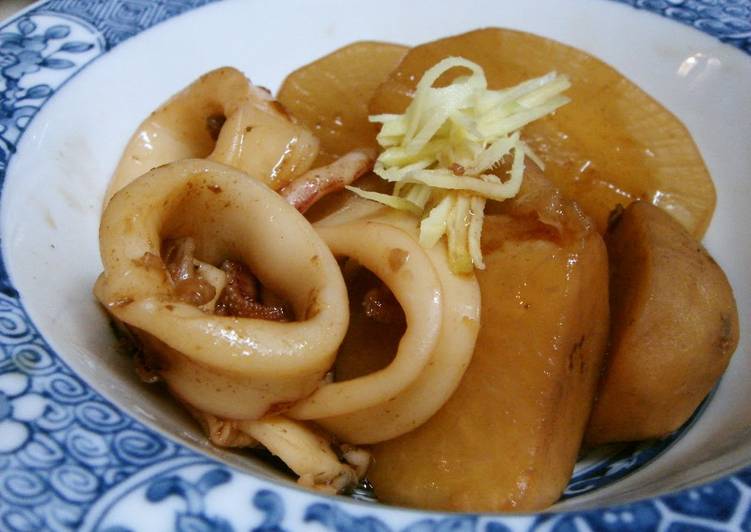
Hello everybody, it is Drew, welcome to our recipe page. Today, we’re going to prepare a special dish, well-flavoured simmered taro roots, daikon radish, and squid. One of my favorites. This time, I’m gonna make it a bit tasty. This is gonna smell and look delicious.
Furofuki Daikon is a simple yet delicious way to enjoy the Japanese Daikon Radish. There are many variations, but this is the basic recipe for this rustic. Sweetness of daikon radish and umami of squid are compatible with each other. add the dashi, soy sauce, mirin and daikon radish and squid tentacles(not body yet) into the pot and boil until daikon become soft lemon flavored Simmered Sweet Potatoes.
Well-Flavoured Simmered Taro Roots, Daikon Radish, and Squid is one of the most well liked of recent trending foods in the world. It is easy, it’s quick, it tastes yummy. It is appreciated by millions daily. Well-Flavoured Simmered Taro Roots, Daikon Radish, and Squid is something that I have loved my entire life. They are fine and they look fantastic.
To get started with this recipe, we must first prepare a few ingredients. You can have well-flavoured simmered taro roots, daikon radish, and squid using 11 ingredients and 6 steps. Here is how you cook that.
The ingredients needed to make Well-Flavoured Simmered Taro Roots, Daikon Radish, and Squid:
- Make ready 4 Taro root
- Get 1/2 Daikon radish
- Get 1 Squid
- Take 100 ml ●Water
- Prepare 3 tbsp ●Sake
- Take 3 tbsp ●Mirin
- Get 1 tbsp ●Sugar
- Take 1 tbsp ●Usukuchi soy sauce
- Prepare 3 tbsp ●Soy sauce
- Prepare 300 ml Dashi stock (bonito dashi powder: 1 teaspoon)
- Take 1/2 thumbtip's worth Ginger
Remove from heat and add daikon. Simmered Taro, is a classic simmered dish in Japan. In Japanese we call this dish Satoimo no If you're unfamiliar with taro, it is a starchy root crop that is known for its nutrition values and essential Well, aside from its many nutrition values, taro is appreciated for its unique texture and ability to soak. There's nothing quite like eating simmered daikon radish.
Instructions to make Well-Flavoured Simmered Taro Roots, Daikon Radish, and Squid:
- Peel the satoimo, and cut large ones into half to match the size. Massage with a little bit of salt, and rinse in water to remove the stickiness.
- Peel the daikon radish, cut in half lengthwise, and into 1 cm wide slices.
- Remove the entrails from the squid, and wash the body and tentacles really well. Cut the body into 1 cm thin round slices. Cut off the tips of the tentacles, and cut in half.
- Add the ● ingredients into a pot, and bring to a boil. Add the squid, simmer for 2-3 minutes, and remove from the pot. Add the 300 ml of dashi stock, taro imo, and daikon radish.
- Put a small lid that sits right on top of the food (an "otoshibuta"), and turn up the heat to high. When it starts to boiling, turn down the heat a little bit, and simmer. Insert a bamboo skewer into the vegetables, and if it goes through smoothly, return the squid to the pot.
- Simmer until the liquid boils down. Shake the pot to coat the vegetables with the sauce. Serve on a plate, garnish with shredded ginger, and you're done.
It's soft and juicy and carries with it all the flavor you could ever want. Today, we're pairing that little magic root with yellowtail and simmering them together. To save some time, we'll be using something that isn't used. Daikon Radish: A Healing Superfood. "When white radishes are in season, doctors should take a break." This root vegetable has a unique ability to support the body as the seasons transition to cooler weather. Daikon radish is available in most Asian markets and some supermarkets, as well.
So that’s going to wrap this up for this special food well-flavoured simmered taro roots, daikon radish, and squid recipe. Thank you very much for your time. I’m sure that you can make this at home. There is gonna be interesting food in home recipes coming up. Don’t forget to bookmark this page in your browser, and share it to your loved ones, colleague and friends. Thanks again for reading. Go on get cooking!


